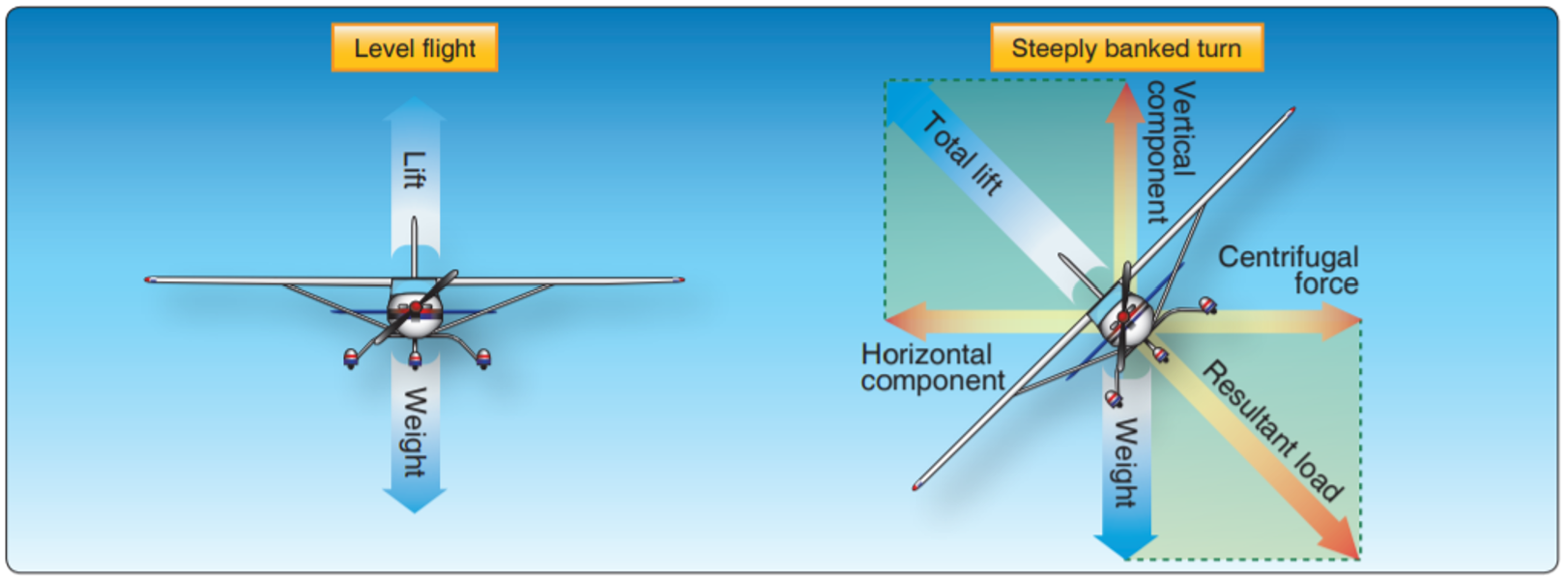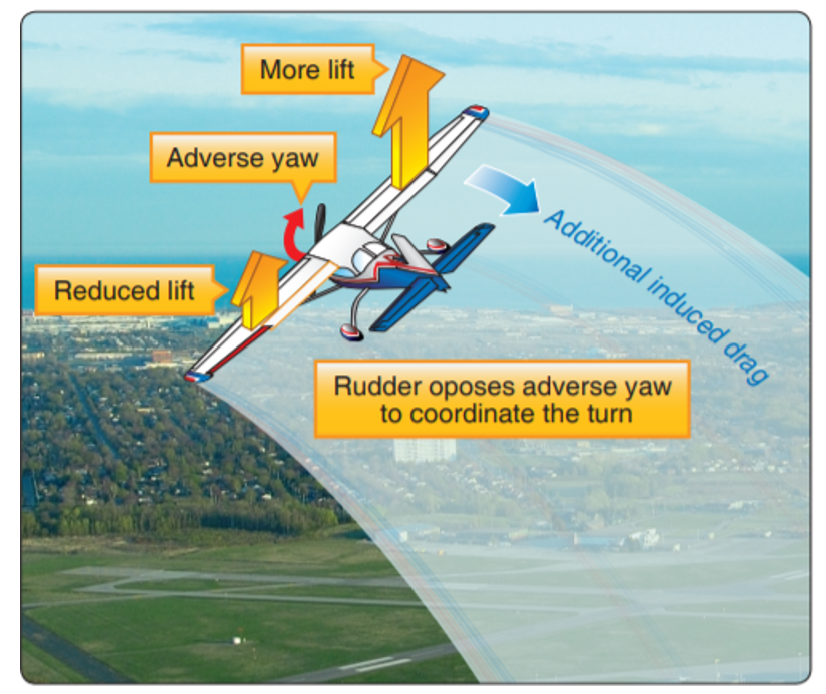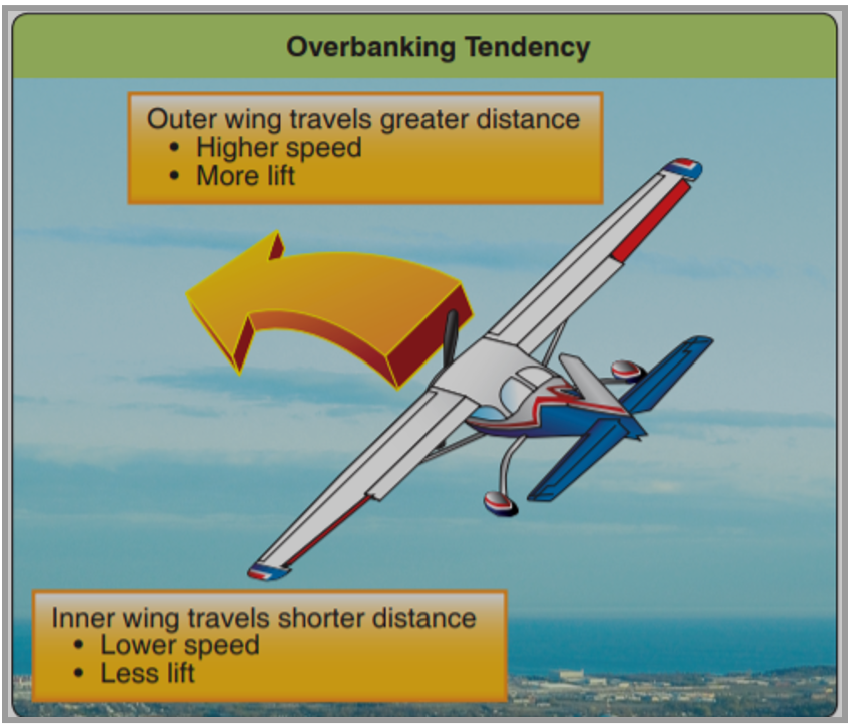Task VIII.B: Level Turns
Lesson Overview
- Objective
-
The student should develop knowledge of the elements related to establishing and maintaining a level turn.
- Reference
-
-
Aircraft Flight Manual / Pilot’s Operating Handbook
-
Airplane Flying Handbook (FAA-H-8083-3) Chapter 3-10
-
- Key Elements
-
-
Increased Back Pressure (HCL/VCL)
-
Coordination (Adverse Yaw)
-
Control Pressures
-
- Elements
-
-
Flight Controls
-
How the Turn Works
-
Control Pressures and Over Controlling
-
Trim Technique
-
Integrated Flight Instruction
-
Level Turns
-
- Equipment
-
-
White board and markers
-
References
-
iPad
-
Model Airplane
-
- Instructor Actions
-
-
Discuss lesson objectives
-
Present Lecture
-
Ask and Answer Questions
-
Assign homework
-
- Student Actions
-
-
Participate in discussion
-
Take notes
-
Ask and respond to questions
-
- Schedule
-
-
Discuss Objectives
-
Review material
-
Development
-
Conclusion
-
- Completion Standards
-
The student has the ability to turn at varying degrees of bank, maintaining altitude and airspeed.
Instructor Notes
- Attention
-
Level turns sound boring and simple, but there is a lot more to turning than you might think, and a strong grasp on this will make many other maneuvers considerably easier.
- Overview
-
Review Objectives and Elements/Key ideas
- What
-
A level turn is a turn at a specified angle of bank in which altitude and airspeed are maintained.
- Why
-
The ability to understand and fly a level turn is essential to the building of every pilot’s skill set. Level turns are the building blocks to many more difficult maneuvers and will help the pilot in his or her control of the airplane.
Lesson Details
Flight Controls
All four primary controls are used in coordination when making turns
-
Ailerons - Bank the wings and determine the rate of turn at a given airspeed
-
Elevator - Moves the nose up or down in relation to the pilot, and perpendicular to the wings
-
It sets the pitch attitude in the turn and “pulls” the nose around the turn
-
-
Rudder - Offsets yaw effects developed by the other controls (is not used to turn the airplane)
-
Throttle - Provides thrust which may be used to maintain airspeed during a turn
How the Turn Works
-
Changing the direction of the wing’s lift to either side causes the airplane to be pulled that direction.
-
This is done by applying coordinated aileron and rudder to bank the airplane
-
Lift
In straight and level flight, the total lift is acting perpendicular to the wings and the Earth.
-
As the plane is banked, lift becomes the resultant of two components.
-
The vertical and horizontal components act at right angles to each other (shown in the picture below); total lift acts perpendicular to the banked wings

Adverse Yaw
When the pilot deflects the ailerons to bank the airplane, both lift and drag are increased on the rising wing, and simultaneously decreased on the lowering wing
-
The aileron on the rising wing is deflected downward producing more lift and therefore more induced drag
The change in drag between the wings results in the airplane yawing opposite the direction of the turn (adverse yaw)
To counteract adverse yaw, rudder pressure is applied simultaneously with aileron in the direction of the turn

Overbanking Tendency
-
As the radius of a turn becomes smaller, a significant difference develops between the speed of the inside wing and the speed of the outside wing
-
The wing on the outside of the turn travels a longer path than the inside wing, but both complete their respective paths in the same amount of time
-
Therefore, the outside wing must travel faster than the inside wing; as a result, it develops more lift
-
The difference in lift between the inside and outside wing tends to further increase the angle of bank
-
-
-
In a shallow banked turn, the difference in lift between the two wings is generally overcome by the airplane’s inherent lateral stability
-
The airplane will have a tendency to roll back to wings level unless the pilot holds aileron pressure in the direction of the turn
-
-
In a medium bank, the lift differential generally matches the airplane’s inherent lateral stability characteristics
-
The aileron can be left neutral and bank will neither increase or decrease
-
-
At a high bank angle (generally > 45o), the difference in lift between the inner and outer wings outweighs the airplane’s inherent lateral stability

-
The aircraft continues in the direction of the bank even with neutral flight controls
-
Aileron pressure is required in the direction opposite the turn in order to maintain the bank angle
-
Rate of Turn
The rate of turn is dependent on airspeed and the horizontal component of lift (bank angle)
-
Horizontal Component of Lift (bank angle)
-
The rate of turn at a given airspeed is dependent on the horizontal component of lift
-
The horizontal component of lift varies in proportion to the amount of bank
-
As bank angle increases, the horizontal component of lift increases
-
Therefore, the steeper the angle of bank, the higher the rate of turn
-
-
-
-
Airspeed
-
As airspeed increases, the aircraft’s rate of turn decreases due to inertia
-
The higher the airspeed of an aircraft, the greater the inertia
-
The greater the inertia, the more the aircraft desires to continue straight ahead and therefore the slower the rate of turn
-
-
At a given angle of bank, a higher true airspeed will make the rate of turn slower, and the radius of the turn larger
-
-
Ask Student: How does airspeed effect the turns inside the pattern, if carying extra speed on base due to a rapid reduction in altitude while on base to final, how does that effect the planned turn to final?
Coordination
-
The ball in the turn and slip indicator will be displaced whenever the airplane is skidding or slipping
-
In proper coordinated flight, there is no skidding or slipping
-
Step on the ball to center it and maintain coordinated flight
-
As discussed above, adverse yaw must be compensated for with rudder pressure in the direction of the turn. Anticipate and add rudder pressure with aileron
-
-
Uncoordinated flight results in decreased performance (excess drag)
-
Reduces airspeed, climb ability, etc.
-
Control Pressures and Over-Controlling
It is important to maintain a light grip on the flight controls
-
Only grip with the fingertips
The control forces desired should be exerted lightly and just enough to produce the desired result
|
⚠️
|
|
Overcoming Tenseness/Over-controlling
It can be easy to over-control the aircraft especially if having a death grip.Obviously, this is mitigated by maintaining a light grip on the flight controls. Try to only grip with the fingertips. This helps to exert only the control pressure needed which should be just enough to produce the desired result.
-
Signs of over-controlling
-
Control movements rather than control pressures
-
Jolty, large movements of the flight controls
-
White knuckles (look for the death grip)
-
Overall nervousness
-
-
Prevention
-
Point out the over-controlling and demonstrate the correct light, fingertip grip and the pressures desired.
-
-
Trim Technique
Most airplanes are designed so that the primary flight controls (rudder, aileron, elevator) are streamlined with the non-movable airplane surfaces when the airplane is cruising straight and level at normal weight and loading.
-
If the airplane is out of that balanced condition (faster, slower, heavier, lighter, etc.), one or more of the control surfaces is going to have to be held out of its streamlined position by continuous control input.
-
Trim tabs/control surfaces offset the constant flight control pressure inputs needed from the pilot
-
A properly trimmed aircraft is an indication of good piloting skills, and should allow the pilot to fly almost hands free
-
Any control forces the pilot feels should be a result of deliberate flight control inputs, not forces being applied by the airplane
-
-
Trimming the Airplane
-
Set the power
-
Set the pitch
-
Let the airspeed stabilize
-
Trim the airplane for the current airspeed
-
Establish and hold the airplane in the desired attitude using the primary flight controls
-
Proper attitude should be established with reference to the horizon and then verified by reference to the flight instruments
-
-
Apply trim to relieve the control pressure
-
The airplane attitude must be established and held first, then control pressures trimmed
-
-
As previously discussed, if power changes, the pitch attitude to maintain level flight will change, and the aircraft will have to be re-trimmed
-
On a longer flight, as the CG changes with decreasing fuel, small adjustments may have to be made to maintain the proper trim
-
-
💥🔥Common Error - Faulty trim technique💥🔥
Trying to fly the airplane with trim is a common fault There is no such thing as the perfect trim — with changing air, gusts, turbulence, fuel burn, etc. the airplane will have to be trimmed often
Integrated Flight Instruction
Each flight maneuver is first learned by reference to outside references, then by instrument references only. This integrated approach will help develop the habit of monitoring the flight and engine instrumentation.
Level Turns
Before turning, clear the area in the direction of the turn and complete the pre maneuver checklist
Entering the Turn, Establishing the Bank Angle
Outside References
-
On most light single-engine airplanes, the top of the engine cowling is fairly flat, and its horizontal surface relative to the natural horizon provides a good indication for initially setting the bank angle and pitch attitude (the wings can also be used as a reference)
-
Use the position of the cowling and/or wings on the natural horizon as your attitude indicator to establish the turn, then crosscheck the turn with the instruments
-
With experience you will learn to associate the outside references with the bank angles and pitch attitudes required in the turn
-
Parallax Error
-
The airplane rolls on the longitudinal axis
-
Because most aircraft have side-by-side seating, each pilot sits to one side of the longitudinal axis
-
For the pilot in the left seat, this results in the nose appearing to rise in a left turn (due to the pilot lowering in relation to the longitudinal axis) and appearing to descend in a right turn (due to the pilot rising in relation to the longitudinal axis).
-
Another common problem is that a pilot may lean away from the turn in order to remain in an upright position in relation to the horizon
-
This should be avoided and corrected immediately in order to properly use visual references
-
Control Inputs
-
Aileron and rudder pressure should be input together
-
Use small, smooth flight control inputs
-
Beginning pilots should not use large aileron and rudder control inputs which produce rapid roll rates and allow little time for the pilot to evaluate and make corrections
-
The faster and more firmly the aileron is applied, the faster the roll
-
The longer the aileron pressure is held, the greater the bank angle
-
Common Error - Application of control movements rather than pressures
-
-
Maintain Coordination
-
Elevator Pressure
-
As the roll is being established, and vertical lift is divided into a vertical and horizontal component, gently increase back pressure to maintain level flight
-
If desired, trim the aircraft to maintain hands free level flight, and reduce pilot workload
-
-
Power
-
As lift is increased to maintain altitude in the turn, drag is also increased, reducing airspeed
-
-
Crosscheck — 90% outside, 10% inside
-
Establish the turn with outside references
-
Crosscheck with the instruments
-
Attitude indicator — Verify desired bank angle and pitch attitude
-
Turn Coordinator — Coordinated flight
-
Attitude Indicator — Should show level flight
-
Vertical Speed Indicator — Should show zero climb. Check for trends
-
Heading Indicator — Turning at a normal rate toward the desired heading
-
Airspeed Indicator — Check for proper airspeed
-
In the Turn
-
Throughout the turn, the pilot should reference the natural horizon, scan for traffic, and occasionally crosscheck the flight instruments
-
Outside References
-
Maintain the desired relationship between the cowling and/or wings with the natural horizon, while scanning for traffic
-
-
Control Inputs
-
Aileron and Rudder (Maintaining Bank)
-
Elevator Pressure (Maintaining Altitude)
-
Power (Maintaining Airspeed)
-
Crosscheck and Adjust — 90% outside, 10% inside
-
Same as above - backup the outside references with the instruments and ensure the desired bank angle, altitude, and airspeed are being maintained, as well as coordinated flight
-
Adjustments
-
If bank angle is too high or low, reestablish the desired bank using the ailerons
-
Once the necessary adjustments have been made, re-trim the airplane
-
During all turns, the ailerons, rudder and elevator are used to correct minor variations in pitch and bank, just as they are in straight-and-level flight
Rolling Out
General/Control Inputs
-
Similar to a roll in except control pressures are used in the opposite direction
-
Since the airplane continues to turn as long as there is any bank, the rollout must be started prior to reaching the desired heading
-
As a general rule, lead the rollout by approximately ½ the bank angle (this is a very slow roll out)
-
In a 30o bank turn, start the rollout 15o before your desired heading
-
-
-
As the angle of bank decreases, elevator pressure should be gently relaxed to maintain altitude
-
As bank is rolled out, the horizontal component of lift is decreasing and the vertical component of lift is increasing
-
-
Power should be reduced to maintain the desired airspeed in straight flight
-
As the wings become level, the control pressures should be smoothly relaxed so that the controls are neutralized as the airplane returns to straight-and-level flight
-
Remove trim, if necessary
-
Attention should be directed to visual references, as well as the flight instruments to determine that the wings are leveled and the turn stopped
Outside References while Rolling Out
The aircraft should be returned to the straight-and-level flight references
-
Crosscheck — 90% outside, 10% inside
-
As straight-and-level flight is reestablished, continue to reference the natural horizon, scan for traffic, and occasionally crosscheck the flight instruments
-
|
⚠️
|
|
Conclusion
Brief review of the main points
In a level turn, we establish and maintain our bank angle and pitch attitude in relation to the horizon. The airplane’s attitude is confirmed by referring to flight instruments and its performance. If the airplane performance, as indicated by flight instruments, indicates a need for correction, a specified amount of correction should be applied with reference to the horizon. Then the airplane’s attitude and performance are rechecked by referring to the flight instruments.
ACS Requirements
- To determine that the applicant
-
-
Exhibits instructional knowledge of the elements of level turns by describing:
-
Effect and use of flight controls.
-
The Integrated Flight Instruction method.
-
Outside and instrument references used for pitch, bank, yaw, and power control; the crosscheck and interpretation of those references; and the control procedure used.
-
Trim procedure.
-
Methods that can be used to overcome tenseness and over controlling.
-
-
Exhibits instructional knowledge of common errors related to level turns by describing:
-
Failure to cross-check and correctly interpret outside and instrument references.
-
Application of control movements rather than pressures.
-
Uncoordinated use of flight controls.
-
Faulty altitude and bank control.
-
-
Demonstrates and simultaneously explains level turns from an instructional standpoint.
-
Analyzes and corrects simulated common errors related to level turns.
-